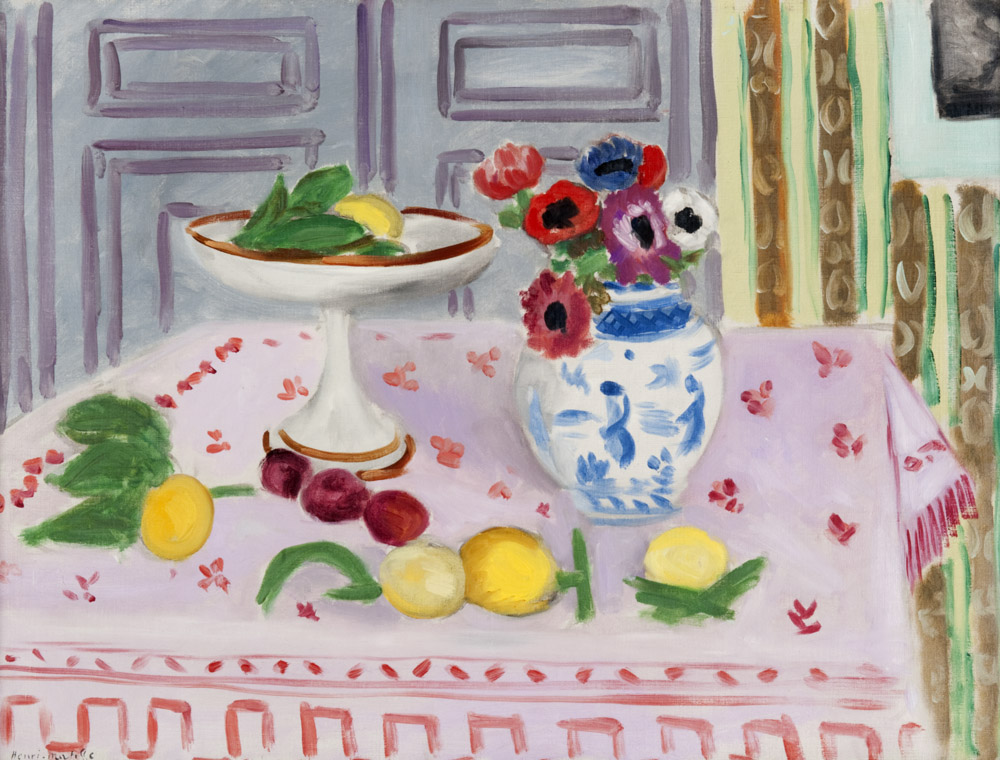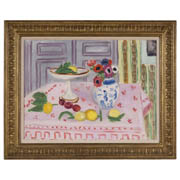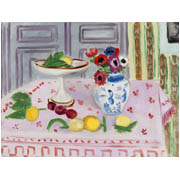Details
- Object type
painting
- Title
The Pink Tablecloth
- Artist/Maker
Henri Matisse artist
- Culture/School
French
- Place Associated
France, Nice (place depicted)
- Date
1924-1925
- Materials
oil on canvas
- Dimensions
framed: 814 mm x 1017 mm x 90 mm; unframed: 603 x 810 mm
- Description
-
Still Life composition within a domestic interior arranged on top of a small square-shaped table covered with ornamental pink tablecloth. Yellows and greens of the fruit scattered in the foreground nicely stand out against the tablecloth, while the three burgundy plums tend to blend in. Ceramic fruit stand and decorative vase full of colourful flowers, as well as panelled door and striped wallpaper in the background are all visually strong elements placed together in one composition, creating thus mixture full of seductive harmonies and compelling disharmonies.
Where Braque and Picasso, intent on challenging our ability to look, expect an intellectual effort on the part of the viewer, Matisse cared only that the viewer relax and find comfort from the cares of daily life by looking at his work. Matisse wanted to communicate the joy and happiness that he experienced when looking. He strove to find a visual equivalent with which he could communicate these emotions. Although accused by some early critics of being a ‘mere decorator’, Matisse was revolutionary in that he successfully found a way of transcribing the three-dimensional world on to a two-dimensional canvas, replacing the plastic volume of ‘realistic’ forms with flat patches of colour.
From 1921 until 1926 Matisse rented an apartment on the third floor at I, place Charles-Félix, in Nice, and it is likely that this still life was painted there. The blue and white vase, the white fruit stand and the pink tablecloth appear in several other still lifes painted in Nice between 1924 and 1925. As in these other works, Matisse uses arears of pure bright, light-filled colour to create an all-over near two-dimensional design that still manages to suggest an air-filled space. By simplifying forms and heightening colours, and by playing shapes and colours off against each other, Matisse creates an object d’art full of seductive harmonies and compelling disharmonies. The white-boarded grey image appears dull against the striped wall paper, the broad straight lines of the panelled wood are bold against the curves of the petals on the patterned tablecloth, and the burgundy of the plums is warm against the acid yellow of the lemons.
By 1925, Matisse was one of the Europe’s most popular painters, and collectors were keen to own his works. William McInnes, the Glasgow collector who acquired this painting and later bequeathed to Glasgow Museums, loved it at first sight. However, it took the gentle persuasion of Scottish Colourist painter Leslie Hunter and dealer A.J. McNeill Reid for him to be brave enough to buy it.
- Credit Line/Donor
Bequeathed by William McInnes, 1944
- ID Number
2402
- Location
Kelvingrove French Art Gallery


